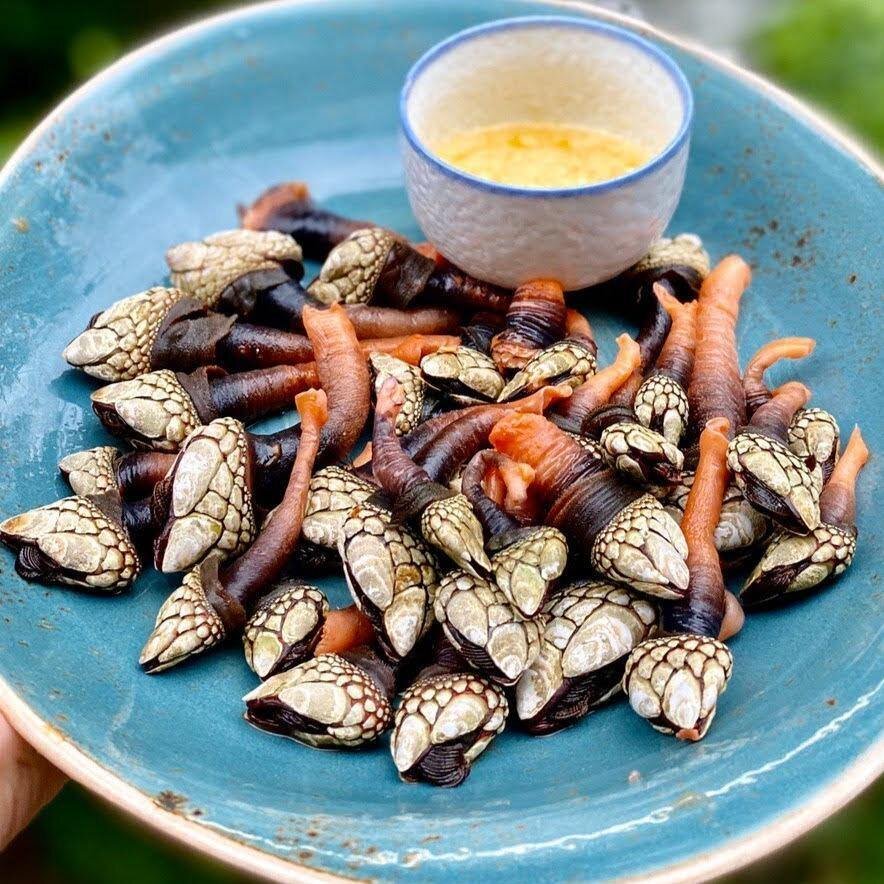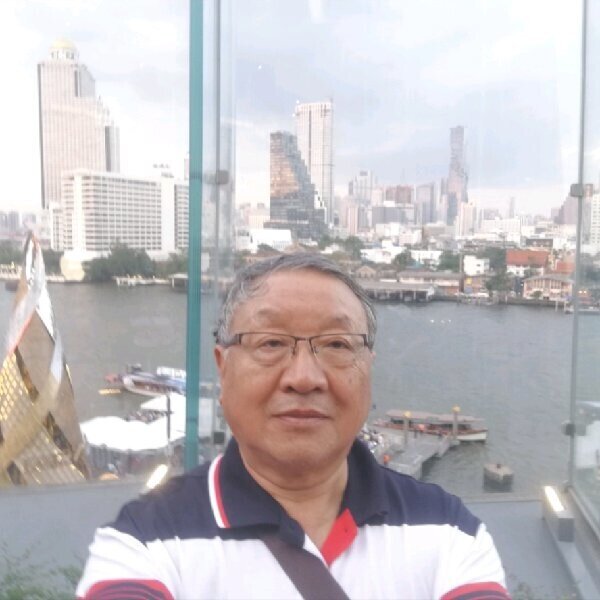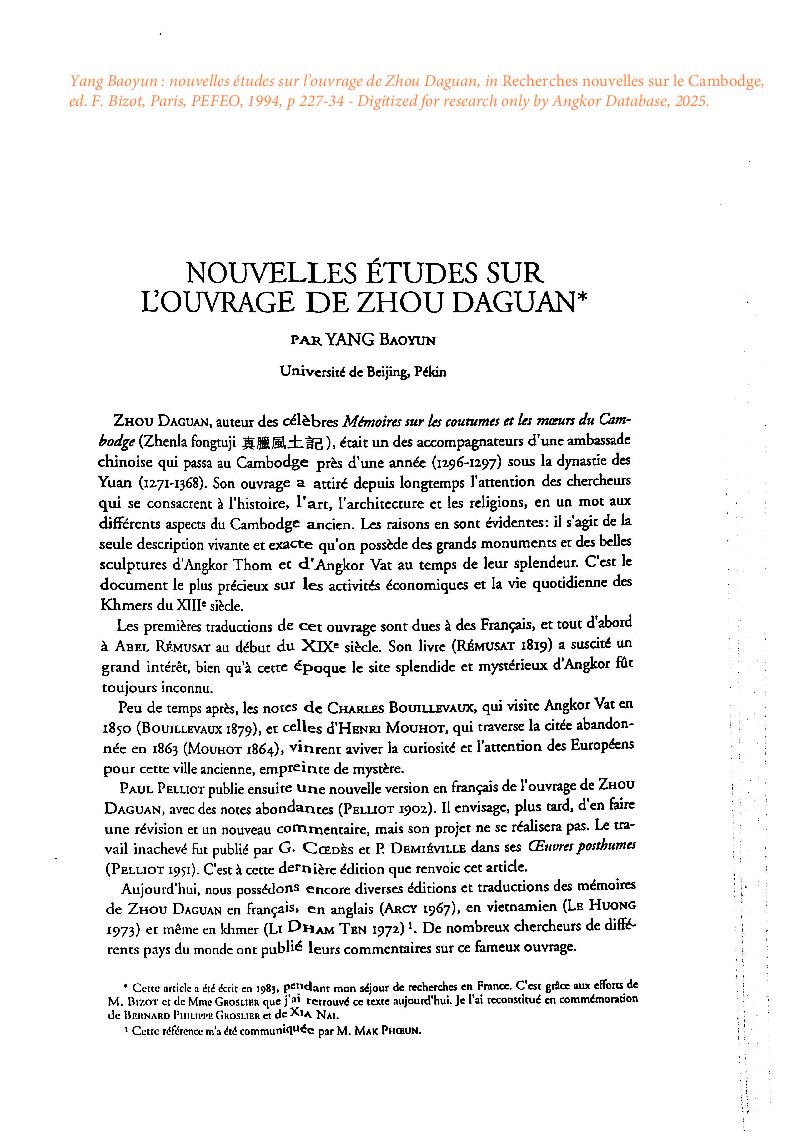Nouvelles études sur l'ouvrage de Zhou Daguan [New Research on Zhou Daguan's account of Angkor]
by Baoyun Yang
A short study of Xian Nai's apportation to a better understanding of Zhou Daguan's essential account on Angkor.

Publication: in Recherches nouvelles sur le Cambodge, dir. Francois Bizot, EFEO, Paris, 1994, ISBN 2-85539-600-x, pp 227-34.
Published: 1994
Author: Baoyun Yang
Pages: 7
Language : French
pdf 5.8 MB
This brief essay dedicated to Bernard-Philippe Groslier and Xia Nai is mostly a comparison of Paul Pelliot’s latest and unfinished translation of Zhou Daguan’s 1296 – 7 travelogue (George Coedes and P. Demieville eds.,1951) and the revised and annotated Chinese edition by Xia Nai (1981). It predated Peter Harris’ English translation (2006) which clarified most of the discrepancies between Pelliot’s and Xia Nai’s versions.
Noting that the latter “a corrigé plus de 80 caractères et en a ajouté plus de 140 par rapport à l’édition du Gujin yishi qui né compte que 8 500 caractères chinois. Plusieurs phrases vagues ou inexplicables sont ainsi éclairées.” [has corrected more than 80 characters and added more than 140 ones to the Gujin-yushi edition which includes 8,500 characters only, hence clarifying several unclear or unexplainable sentences.”], the author proposes to amend Pelliot’s version on several points, including:
- in Zhou Daguan’s itinerary in Cambodia (Introduction),
dans la version de PELLIOT, lorsque ZHOU DAGUAN présente son itinéraire pour aller au Cambodge, on lit: «De l’embouchure, par courant favorable, on gagne au Nord, en quinze jours environ, un pays appelé Tch’a-nan» (PELLIOT 1951:9). Mais XIA NAI y ajoute le caractère Xi 西 «Ouest» d’après l’édition du Shuofu (A) 說郛 (甲), la direction est ainsi devenue: «on gagne au Nord-Ouest…» (ΧΙΑ 1981:15). GEORGE Cœdès et, après lui, tous les commentateurs, identifient Canan 查南 (Cha-nan) à Kompong Chhnang, qui se trouve au Nord-Ouest de l’embouchure du Mékong. Cette correction a donc rendu plus exacte la direction du voyage de ZHOU DAGUAN. [In PELLIOT’s version, when ZHOU DAGUAN presents his itinerary to go to Cambodia, we read: “From the mouth, by favorable current, one reaches to the North, in about fifteen days, a country called Tch’a-nan” (PELLIOT 1951:9). But XIA NAI adds the character Xi 西 “West” according to the edition of Shuofu (A) 說郛 (甲), the direction thus became: “one reaches to the North-West…” (XIA 1981:15). GEORGE Cœdès and after him all the commentators, identify Chanan 查南 (Cha-nan) with Kompong Chhnang, which is located to the North-West of the mouth of the Mekong. This correction therefore made the direction of ZHOU DAGUAN’s journey more accurate.] [ADB note: Peter Harris kept plain “North” in his translation.]
- Military ranks under the Yuan Dynasty:
Dans la version de PELLIOT, on lit qu’il [l’auguste mandat du ciel] envoya une fois, pour se rendre ensemble jusqu’en ce pays-ci, un centurion avec insigne au tigre et chiliarque à la tablette d’or…» (PELLIOT 1951:10). Mais, selon l’édition du Shuofu (A), c’était «un Wanhu 萬戶 avec insigne au tigre» 虎符萬戶.Conformément aux règlements de la dynastie des Yuan, il y avait trois principaux grades militaires: Wan-bu (chef de dix mille), Qianhu 千戶 (chef de mille ou chiliarque) et Baihu 百戶 (centurion). Le Wanhu était le grade le plus haut et commandait au moins à trois milles soldats; le Qianhu devait suivre ses ordres. Pour les distinguer, le Wanhu portait un insigne d’or en forme de tigre couché, le Quanhu avait une tablette d’or et le Baihu avait une tablette d’argent. A cette époque, la Cour impériale des Yuan a donc envoyé un Wanhu comme ambassadeur et un Qianhu comme adjoint, ce qui reflète la grande attention accordée au Cambodge. Après avoir étudié ce système des officiers de la dynastic des Yuan, XIA NAI accepte donc l’indication du Shuofu (A) (ХДА 1981:38). [In PELLIOT’s version, we read that he [the august mandate of heaven] once sent, to go together to this country, a centurion with a tiger insignia and a chiliarch with a golden tablet… (PELLIOT 1951:10). But, according to the Shuofu (A) edition, it was “a Wanhu 萬戶 with a tiger insignia” 虎符萬戶. According to the regulations of the Yuan Dynasty, there were three main military ranks: Wan-hu (leader of ten thousand), Qianhu 千戶 (leader of a thousand or chiliarch) and Baihu 百戶 (centurion). The Wanhu was the highest rank and commanded at least three thousand soldiers; the Qianhu had to follow his orders. To distinguish them, the Wanhu wore a golden insignia in the shape of a lying tiger, the Quanhu had a golden tablet, and the Baihu had a silver tablet. At that time, the Yuan imperial court therefore sent a Wanhu as an ambassador and a Qianhu as a deputy, which reflects the great attention paid to Cambodia. After studying this system of Yuan dynastic officers, Xia Nai therefore accepts the indication of Shuofu (A) (XDA 1981:38).] [Harris uses the word “tally” for the insignia of these officers, gold or silver pieces decorated with a miniature tiger cut in two, one part given to the officer (general and colonel, respectively) and one kept at the Court.]
- Roofs or buildings?
Chapitre 2 , “Les toits (?) sont imposants” 屋頭壯觀 (PELLIOT 1951:12). NAI a indiqué, d’après le Shuofu (A), que cette phrase doit être la suivante: «Les batiments sont assez imposants» 屋頗壯觀 (X1A 1981:64). Etant donné la ressemblance des deux caractères chinois tou 頭 «tête» et po 頗 «assez», il est fort probable qu’il s’agisse d’une faute de copiste. [Chapter 2, “The roofs (?) are imposing” 屋頭壯觀 (PELLIOT 1951:12). NAI indicated, according to the Shuofu (A), that this sentence should read: “The buildings are quite impressive” 屋頗壯觀 (X1A 1981:64). Given the resemblance of the two Chinese characters tou 頭 “head” and po 頗 “enough”, it is very likely that this is a copyist’s error.] [ADB note: Harris: “The rooms are quite grand-looking.]
- Again about zhentan:
CHAPITRE 8: LES JEUNES FILLES. À la phrase «Il y a aussi des gens qui donent de l’argent pour le tchen-t’an [zhentan] 陣毯 des familles pauvres…» (PELLIOT 1951:18), ΧΙA NAI corrige selon le Shuofu (A): «Il y a aussi des familles riches (fujia 家) qui donnent de l’argent pour…» (ΧΙΑ 1981:107). [CHAPTER 8: THE YOUNG GIRLS. In the sentence “There are also people who give money for the tchen-t’an [zhentan] 陣毯 of poor families…” (PELLIOT 1951:18), XIA NAI corrects according to the Shuofu (A): “There are also rich families (fujia 家) who give money for…” (XIA 1981:107).] [ADB note: [Harris’ translation is more precise, with “some wealthy families” helping poorer families with money for their daughters’ zhentan, “which they call doing good work.” This notation is important as it ធម្ម dhamm /thoəm/;2 Skt dharma ‘natural order, esp. law, justice; virtue; good works; religious merit, religious devotion’, < √dhṛ ‘to hold, bear, maintain, preserve’]. 1. n.Established (natural, cosmic, social) order, the absence of imbalance: right, justice, equity; law, rule, custom, tradition.3 2. n. Adherence to or respect for order, prescribed conduct, virtue, morality. 3. n. Act of piety or devotion, good or pious works. 4. n. Ethical precepts (of Buddhism), the Buddhist
- Maternal uncle:
CHAPITRE 10: LE LANGAGE. — PELLIOT traduit «…oncle maternel [se dit] k’i-lai (khlai) 吃賴; mari de la tante paternelle aussi k’i-lain (PELLIOT 1951:20). ΧΙΑ ΝΑΙ estime que, selon le Shuofu (A), cette phrase n’est pas complète. Elle doit se lire: *… oncle maternel, k’i-lai [chi-lai]; mari de la tante paternelle, de la sœur aînée, de la tante maternelle, de la sœur cadette également k’i-lai » 姑夫、姊夫、姨夫、妹夫亦呼為吃賴(ΧΙΑ 1981:112). [Chapter 10: Language. — Pelliot translates “…maternal uncle [is] *k’ilai* (khiai) 吃粮; paternal aunt’s husband also *k’ilai*” (Pelliot 1951:20). Xia Nai believes that, according to the *Shuofu* (A), this phrase is incomplete. It should read: “…maternal uncle, *k’ilai* [chi-lai]; paternal aunt’s husband, elder sister’s husband, maternal aunt’s husband, younger sister’s husband are also called *k’ilai*” 姑夫·姨夫·姨夫·妹夫亦呼為吃粮 (Xia 1981:112).]
- Public writers?
CHAPITRE 12: L’ÉCRITURE. — Une phrase de PELLIOT n’est pas correcte: «Pour les pétitions, il y a aussi les boutiques d’écrivains où on les écrit» (PELLIOT 1951:21). Mais selon le Shuofu (A), c’est tout le contraire: «… il n’y a pas non plus de boutiques d’écrivains où on les écrit»亦無審舖書寫. Ainsi, avec la phrase précédente, on lira: «Ils n’ont aucun sceau, il n’y a pas non plus…», le Shuofu (A) est donc plus logique (XIA 1981:119). [Chapter 12: Writing. — A phrase in Pelliot is incorrect: “For petitions, there are also writer’s shops where they are written” (Pelliot 1951:21). But according to the *Shuofu* (A), it is the opposite: “…there are also no writer’s shops where they are written” 亦無審錯書寫. Thus, with the preceding phrase, it reads: “They have no seal, there are also no…” The *Shuofu* (A) is therefore more logical (Xia 1981:119).]
- Warring Siamese
CHAPITRE 34: LES VILLAGES. — XIA NAI a modifié la phrase “Récemment, au cours de la guerre avec le Siam, [les villages] ont été entièrement dévastés» (PELLIOT 1951:32) en «A cause des nombreuses guerres avec les Siamois, [les villages] ont été entièrement dévastés» 因屢與還人交兵遂至皆成曠地 selon l’édition du Shuofu (A) (Xia 1981:174). [Chapter 34: Villages. — Xia Nai changed the sentence “Recently, during the war with Siam, [the villages] were completely devastated” (Pelliot 1951:32) into “Due to numerous wars with the Siamese, [the villages] were completely devastated” 因屡與遇人交兵遂至皆成喷地 according to the *Shuofu* (A) edition (Xia 1981:174).
- Wenzhou Dialect
XIA NAI note que la traduction de PELLIOT du mot guijiao 龜腳, «les pattes de tortue» (PELLIOT 1951:29), est aussi une erreur due à son ignorance du dialecte de Wenzhou, pays natal de ZHOU DAGUAN et de lui-même. Il montre que guijiao est un mot du dialecte de cette région pour désigner une sorte de moule dont le nom scien-tifique est mitella mitella. En chinois, on l’appelle shiyou 石蚴. De nos jours, les habitants de la région de Wenzhou l’appellent encore guijiao. [Xia Nai notes that Pelliot’s translation of the word guijiao 龜腳, “turtle legs” (Pelliot 1951:29), is also an error due to his ignorance of the dialect of Wenzhou, the native country of Zhou Daguan and himself. He shows that guijiao is a word from the dialect of this region for a type of mussel whose scientific name is mitella mitella. In Chinese, it is called shiyou 石蚴. Today, the inhabitants of the Wenzhou region still call it guijiao. ADB Input: Harris translates as “goose-necked barnacles”.]
Insight about Zhou Daguan’s Vietnamese translation:
When mentioning Lê Hương [tr.], Chân Lạp phong thổ ký [The Customs of Zhenla], Saigon, Kỷ Nguyên Mới Publishers, 1973, the author stresses the Vietnamese translated “worked directly from the Chinese while consulting Pelliot’s version.”*
Photo: goose-necked barnacle, called percebes in Spanish and pouce-pied in French, a gourmet delicacy for Western palates alike (photo salmonmarket.com).
Tags: Zhou Daguan, translations, historiography, Chinese studies, zhentan
About the Author

Baoyun Yang
Yang Baoyun 杨保筠 is a researcher in Indian and Taoic religions, as well as Chinese foreign relations history at University of Peking, School of International Studies (SIS), Beijing, China, an adivsor to the Center for Southeast Asian Studies, Beijing, and a visiting professor in ASEAN history at Pridi Banomyong International College, Thammasat University, Thailand.
His PhD thesis at Peking University in 1981 dealt with Funan, and was titled: “Présentation générale de l’histoire du Funan, Première étude sur la forme sociale du plus ancien État du Cambodge.” In 1982 – 1983, he attended Bernard-Philippe Groslier’s lectures at EHESS, Paris. In 1995, he presented a summary of Chinese studies on Cambodia to the ‘Colloque de Phnom Penh sur la langue et culture khmeres’, an international gathering attended by most of the specialists in Cambodian archaeology and history.
Publications
- Contribution à l’histoire de la principauté des Nguyên au Vietnam méridional (1600−1775), Geneve, Olizane, 1992.
- “Nouvelles etudes sur l’ouvrage de Zhou Daguan”, in Recherches nouvelles sur le Cambodge, ed. F. Bizot, EFEO, 1994. [text initially written in 1983]
- “Les sources historiques en caractères chinois: un trésor pour les recherché sur l’histore du Cambodge”, Péninsule 1, 1994, pp. 45 – 50.
- “Les recherches sur le Cambodge en Chine,” in Bilan et perspectives des études khmères (langue et culture) : actes du colloque de Phnom Penh, 29 – 30 novembre-1er décembre 1995, ed. Pierre L. Lamant, Paris, 1997, p 239 – 49.
- “Les relations historiques avec la Chine et le Cambodge”, Péninsule 34 (1), 1997.
- “ ‘Confiance et prudence’ : la diplomatie chinoise au début du XXIe siècle”, Revue internationale et stratégique 44(4), Nov. 2001.
- “La Chine et la Russie”, Outré-Terre 4 (3), Aug.2003.
- “China and Asia-Europe Relations”, International Studies 42(3 – 4):347 – 355, Sept. 2005.

